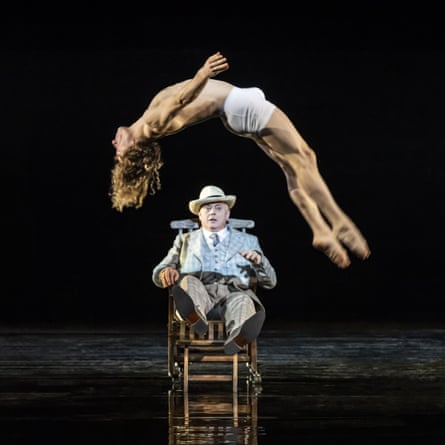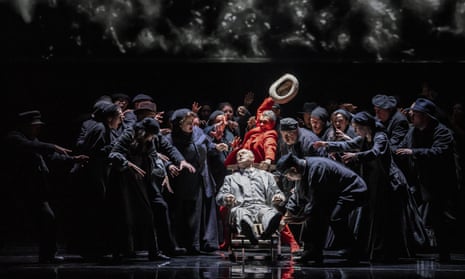Welsh National Opera’s collaboration with NoFitState circus in Benjamin Britten’s final opera has created a stunning spectacle. Based on Thomas Mann’s novella, the work makes huge demands on the tenor singing the role of Gustav von Aschenbach – heroically sung here by Mark Le Brocq – yet this is an opera that stands or falls on the casting of the beauteous vision who is Tadzio. He is the Polish boy held in increasingly obsessive thrall by Aschenbach, searching for blessed release from the pain of writer’s block. Tadzio is a non-speaking role normally given to a dancer, but director Olivia Fuchs here introduces a whole new spatial dimension in the form of the Belgian aerialist Antony César. It is indeed his supreme grace and athleticism that holds the whole audience in his thrall.

Taking the idea a step further, Fuchs makes Tadzio’s whole Polish family acrobats – Diana Salles the tightrope and aerialist mother – and there are several interventions that animate what are sometimes seen as the longueurs of Britten’s score. The sequences of aerial and circus skills bring an distinct element of Marcel Carné’s film Les Enfants du Paradis. This, together with the allusions to angels of light, is a counterbalance to the seven roles sung by baritone Roderick Williams, different manifestations of a single figure whose underlying sinister nature - his old gondolier the harbinger of death – make him more Aschenbach’s nemesis than alter ego. Williams’ characterisations are brilliant and agile, some more robustly projected vocally than others.
Designer Nicola Turner’s setting is mainly monochromatic, a black box with video spreading slowly lapping water in evocative cyclorama footage on the rear wall. Guests at the Lido’s Grand Hotel des Bains are all Edwardian elegance in white; the populace wear dark grey, against which white wings and later Venetian masks stand out. The dark, crepuscular mood symbolising Aschenbach’s desperate need for the returning light of inspiration also suggests the insidious onset of cholera. Based again on Mann’s experience of the 1911 epidemic in Venice, its threat feels all too real in the wake of Covid.

Vivid colour comes with Alexander Chance’s golden Apollo, presiding over the Olympian games which prompt Aschenbach’s realisation that he loves Tadzio, and then competing with Williams’ scarlet-suited Dionysius – beauty versus passion – for the soul of the sleeping writer. There is less eroticism in this dream than in the Tadzio’s final combative pas de deux with Riccardo Saggese’s Jaschiu, who doubles as the Polish governess. Tadzio’s head is not forced into the sand as Britten directed but, in ceding to his opponent’s superior strength, raises his lips to him in a kiss. This is the moment of Aschenbach’s demise.
A strong presence throughout, Le Brocq conveys in both deeply sympathetic voice and in body language Aschenbach’s anguish. Leo Hussain conducts with a sure hand, the WNO chorus is terrific as are the many cameo roles, the WNO orchestra relishing the textures, with scintillating percussion playing, wind lines and periodic brass resonance. The brief final threnody spells heartbreak, but also ultimately serves to reinforce the suspicion that the circus element– thrilling as it is – has denied Britten’s wonderful music its primacy. It’s not an insignificant reservation in an otherwise captivating staging.
At Venue Cymru, Llandudno on 13 March and touring until 11 May.

Comments (…)
Sign in or create your Guardian account to join the discussion